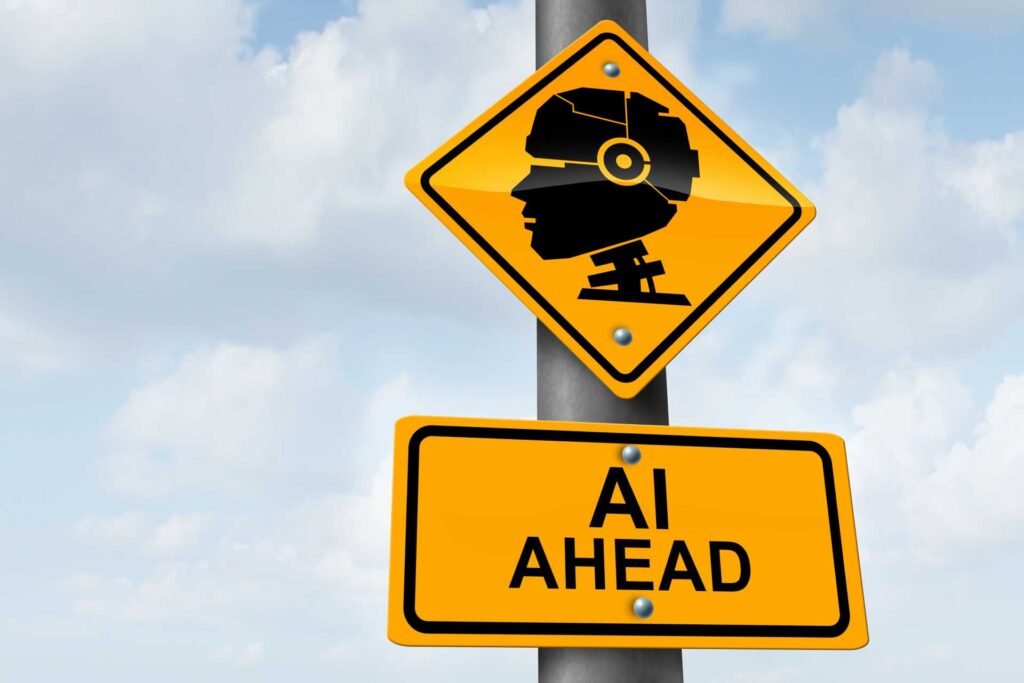Let me share something that's been keeping me up at night – and it should be keeping you up too. After two decades in digital marketing, I've watched plenty of shifts that promised to “change everything.” Most turned out to be evolutionary tweaks wrapped in revolutionary marketing speak. But this AI thing? This is different. This is the quiet transformation that's happening while most of us are still fighting yesterday's war.
I've been tracking the data across dozens of client sites, and what I'm seeing should worry every marketer who's built their career on traditional search optimization. The battlefield has shifted beneath our feet, and most of us don't even realize we're shooting at ghosts.
Here's what I've learned about why your search-first strategy is becoming obsolete – and what you need to do about it before it's too late.
When Pull Marketing Was King (And We All Got Comfortable)
Remember the good old days? Google's promise was beautifully simple: “Be found when people are looking.” For over two decades, we lived in pull marketing paradise. High-intent keywords, conversion funnels, attribution models that actually made sense – it was a marketer's dream.
I built my entire early career on this foundation. Find the searches, optimize for the clicks, measure the conversions, rinse and repeat. The math was clean: higher rankings meant more traffic, more traffic meant more leads, more leads meant more revenue. We could track every dollar and justify every campaign with spreadsheets that made CFOs smile.
But here's what we all ignored while we were busy fighting over the same high-intent searches: we were playing a zero-sum game. Your gain was literally a competitor's loss. Costs kept rising as competition intensified, and we kept convincing ourselves that better optimization would solve everything.
Spoiler alert: optimization alone won't save us from what's coming.
The AI Revolution We Should Have Seen Coming (The Clues Were All There)
Ever since ChatGPT dropped in November 2022, the writing has been on the wall for those of us paying attention. I remember the exact moment it clicked for me – watching my 16-year-old nephew ask ChatGPT about SEO strategies instead of opening Google. When the AI gave him a comprehensive answer, he didn't click through to read my blog post or anyone else's. He got his answer and moved on.
Actually, if I'm being honest, the clues were there even earlier. Voice search devices had been training users for conversational queries since Alexa launched in 2014. Google's shift toward entity-based optimization and featured snippets was already rewarding authoritative, comprehensive answers over keyword-stuffed content. The rise in zero-click searches showed users were getting comfortable with immediate answers rather than browsing multiple sources. ChatGPT didn't create new behavior – it just made the inevitable impossible to ignore.
That behavior shift? It's been accelerating every month since ChatGPT's release, and the clues have been staring us in the face.
I've been tracking this evolution across my client portfolio since early 2023, documenting each subtle shift. First, we noticed people spending more time researching through AI chatbots before even hitting Google. Then came the gradual decline in search volume for certain query types as users got comfortable asking AI assistants directly. When Google finally rolled out AI overviews in 2024, it simply accelerated trends that were already in motion. Now we're seeing fundamental changes in traffic quality – the users who do click through from search results are increasingly lower-intent, less informed, and harder to convert.
The high-quality traffic? AI has been steadily intercepting it since the day Google started rolling out AI overviews.
Think about your own behavior evolution over the past two years. How often do you scroll past an AI overview to click on traditional search results now versus when AI answers first appeared? When did you last visit five different websites to compare products instead of asking an AI assistant to synthesize the information?
We're not witnessing a sudden collapse of the traditional search journey – we're seeing the completion of a transformation that's been building momentum since that pivotal ChatGPT moment. Most marketers are still optimizing for customer behavior patterns that have been steadily disappearing for over two years.
The Push-Pull Framework That Shaped Everything
Before we dive into solutions, let me clarify what we're actually talking about when we say “push” versus “pull” marketing – because AI is about to scramble these definitions in ways that would make Philip Kotler's head spin.
Traditional pull marketing was all about demand capture. You positioned yourself to be found by active searchers who already knew they had a problem and were actively looking for solutions. Search ads, SEO, review optimization – the whole performance marketing playbook focused on harvesting existing demand with razor-sharp targeting and immediate measurable returns.
Push marketing, on the other hand, was about demand creation. You interrupted audiences to create awareness and interest through broad-reach campaigns focused on emotional connection and long-term brand building. Think TV ads, display campaigns, content marketing that told stories rather than answered specific queries.
For years, we treated these as separate disciplines with different teams, different budgets, and different success metrics. Brand teams worried about awareness and recall while performance teams obsessed over cost-per-acquisition and return on ad spend.
Here's what I've discovered through painful trial and error: AI doesn't give a damn about our organizational silos.

Welcome to the AI Era (Where Everything Changes)
AI systems are creating a convergence effect that's making our traditional push-pull divide not just obsolete, but counterproductive. Let me explain what I mean with a real example from my own experience.
Last month, I published a comprehensive analysis of local SEO trends that took weeks to research and write. Within days, I started noticing that when people asked AI assistants about local SEO strategies, my insights were being cited and synthesized into their responses. My “push” content – designed for thought leadership and brand building – was suddenly becoming the foundation for “pull” success as AI systems recommended approaches based on my research.
That's the new dynamic: your brand awareness directly impacts AI recommendation likelihood, and your expertise content becomes the training data that determines whether AI systems know enough about you to recommend you at all.
In the AI era, push marketing has a new objective: becoming part of AI's knowledge base. This means creating thought leadership that establishes category authority, publishing proprietary research that gets cited, and building consistent brand messaging that AI systems recognize and remember.
Pull marketing's objective has evolved too: optimization for AI retrieval and recommendation. This goes way beyond traditional SEO to include creating content that AI systems cite as authoritative, building expertise signals that algorithms trust, structuring information in ways that AI can easily understand and reference, and implementing emerging protocols like llms.txt files that help AI systems quickly understand your authority and expertise.
The symbiotic relationship is what most marketers are missing. Your push content becomes the foundation for pull success. Brand equity directly influences AI recommendation algorithms. The content you create for awareness also serves as AI training data that determines future recommendations.
Why This Matters Right Now (The Window is Closing)
Here's the uncomfortable truth I've had to accept: AI models are being trained on today's content. The brands establishing authority in AI responses right now are creating advantages that will compound for years. We're not just competing for today's customers – we're competing to be remembered by the AI systems that will mediate tomorrow's purchasing decisions.
I've seen this movie before with early SEO adoption, social media platform growth, and mobile optimization. The brands that moved first captured disproportionate benefits that lasted for years. The ones that waited found themselves fighting uphill battles against entrenched competitors.
The cost of waiting is real and measurable. Competitors are already establishing authority in AI responses. It's getting harder to break into AI recommendation lists as the knowledge base becomes more established. And the awareness of AI optimization is growing, which means costs will rise as more marketers wake up to this reality.
The measurement challenge is equally daunting. Our traditional attribution models are breaking down when customers interact with AI intermediaries instead of clicking directly from search results. We need new metrics, new KPIs, and frankly, a cultural shift toward long-term thinking in an industry obsessed with quarterly performance.
How to Explain This to Your Clients (The Elevator Pitch Version)
Here's the reality: you're going to need to sell this strategic shift to clients who still think “AI” means chatbots on customer service pages. After explaining this transformation dozens of times over the past year, I've learned what resonates and what makes their eyes glaze over.
The simple version goes like this: “Remember how Yellow Pages worked? Businesses paid to be listed so customers could find them when they were ready to buy. Google search worked the same way – you optimized to be found when people searched for your solutions. But now, instead of people searching and browsing through options, they're asking AI assistants for recommendations. AI gives them one answer, not a list of choices. If AI doesn't know about your brand or doesn't trust your expertise, you don't exist in that recommendation.”
The business impact translation: “This means two things for your marketing budget. First, we need to become the source that AI systems cite as authoritative in your industry. That requires consistent thought leadership and expertise content. Second, we need brand recognition so when people ask AI about solutions like yours, your company comes to mind. The brands investing in this now are becoming the default recommendations. The ones waiting are becoming invisible.”
The urgency factor: “AI systems are learning who to trust right now, today. The companies that establish authority while there's less competition will have advantages that compound for years. Waiting means playing catch-up against competitors who are already being recommended by AI.”
I've found that focusing on the “being the recommended option” angle rather than getting lost in technical details helps clients understand why this isn't just another marketing trend to ignore.
Your AI-Era Playbook (What to Do Starting Today)
Based on my testing and implementation across multiple client accounts, here's what actually works:
Immediate actions for the next six months: Audit your current content for AI optimization potential. I use a simple framework: “Would an AI system cite this as authoritative?” If the answer is no, either improve it or deprioritize it. Create a comprehensive llms.txt file that serves as your brand's AI introduction. This isn't just about following a new protocol – it's about curating exactly how AI systems understand and represent your expertise. I've been testing different approaches across client sites, and the brands with well-structured llms.txt files are getting cited more frequently in AI responses. Start developing thought leadership content that establishes your expertise in specific areas. Begin investing in brand awareness campaigns that create the mental availability AI systems need to recommend you.
Medium-term strategy for the next 6-18 months: Create comprehensive knowledge resources that become go-to references in your industry. I've seen remarkable success with in-depth guides that answer entire topic clusters rather than individual keywords. Build consistent brand messaging across all channels – AI systems recognize and reinforce consistent signals. Develop content formats optimized for AI consumption, including structured data and clear information hierarchies.
Long-term vision for 18+ months and beyond: Achieve recognition as a category authority that AI systems consistently cite. Build self-reinforcing loops where brand recognition leads to AI citations, which leads to more brand recognition. Establish measurement frameworks that account for AI-mediated interactions and assisted conversions.

What Marketing Looks Like in Five Years
Let me paint you a picture of where this is heading, based on current trajectories and early indicators I'm tracking.
The customer journey is being fundamentally rewired. Discovery happens through AI-mediated conversations rather than search queries. Research is conducted through dialogue with AI assistants that synthesize information from sources customers never directly visit. Purchase decisions are increasingly influenced by AI recommendations that factor in brand familiarity, expert authority, and content quality signals.
In this new world, brand familiarity becomes the ultimate competitive moat. Traditional conversion funnels become obsolete because customers interact with AI intermediaries throughout their decision process rather than following linear paths through your website.
The marketers who thrive will be those who excel at brand storytelling, content authority building, and AI platform optimization. They'll think strategically about long-term brand equity rather than tactically about short-term conversions.
Organizations will need to break down silos between brand and performance teams because the distinction becomes meaningless when AI systems treat all your content as interconnected signals of authority and trustworthiness.
The Choice Before Us
Here's what I know for certain after 20+ years in this business: AI's growth is inevitable. The technology will only get better at understanding, synthesizing, and recommending information. The marketers who continue clinging to outdated strategies will find themselves fighting increasingly expensive battles for diminishing returns.
But here's what excites me: there's still time to adapt. The AI knowledge bases are still forming. The algorithms are still learning which brands to trust and recommend. The competitive landscape is still fluid enough for smart marketers to establish lasting advantages.
The question isn't whether AI will reshape how customers discover and choose brands – it's whether you'll be among the early adapters who help shape that future or among the laggards who spend years trying to catch up.
Based on everything I've learned, tested, and implemented, here are the five things you need to remember:
AI is fundamentally changing how people discover and choose brands, making traditional pull marketing insufficient on its own. Push and pull must work together in a new hybrid approach where brand building directly impacts AI discoverability. The brands establishing authority in AI responses now are creating compound advantages for the future. We need new measurement frameworks that account for AI-mediated customer interactions. Most importantly, the window for influencing AI knowledge bases is narrowing – the time to start building for the AI future is today.
I've been wrong about plenty of things in my career, but I've learned to recognize the difference between hype and genuine transformation. This isn't just another marketing trend to optimize for – it's a fundamental shift in how information flows between businesses and customers.
The brands that understand this early and adapt accordingly won't just survive the transition – they'll dominate it.
What's Next: The LLMS Amplifier Launch
Speaking of building for the AI future – I've been quietly developing something that addresses everything we've discussed in this article. After months of testing llms.txt implementations, experimenting with llms-full.txt protocols, and refining AI optimization (AIO) strategies across dozens of client sites, I'm finally ready to share what's been moving the needle.
The LLMS Amplifier plugin and comprehensive course launch is coming soon, and it's going to spill all the beans on the tactical approaches that are actually working. We're talking about the specific file structures, content optimization techniques, and strategic implementations that are getting brands cited consistently in AI responses.
The course will walk you through the exact frameworks I use to audit content for AI optimization, the step-by-step process for creating llms.txt files that actually get noticed, and the advanced llms-full.txt strategies that are giving early adopters unfair advantages. The custom plugin will implement it for you.
This isn't theory – it's battle-tested methodology from someone who's been tracking AI citation patterns since ChatGPT launched.
If you want to be among the first to know when the LLMS Amplifier drops, keep an eye on my updates. The brands that implement these strategies early won't just adapt to the AI era – they'll help define it.

